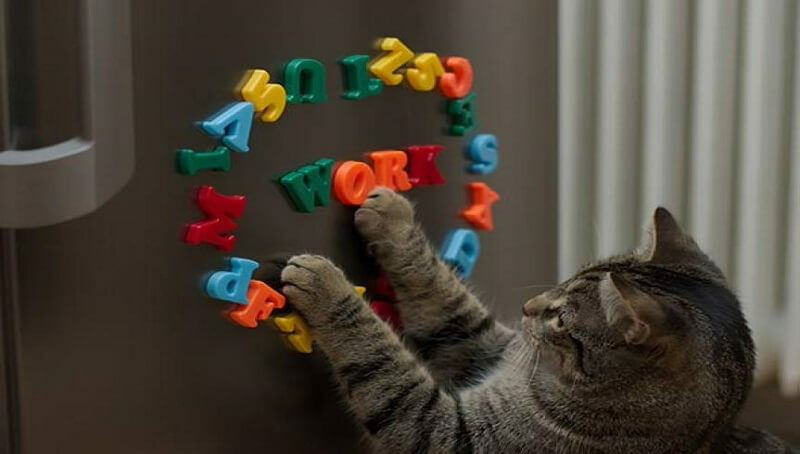
How Long Do Dogs Live With Cancer?
February 7, 2023
Can Dogs Have Panic Attacks?
February 8, 2023
Highlights Section: Understanding the Feline Mind
1. Cats Understand Human Cues: Contrary to the aloof image cats often bear, research reveals they can indeed comprehend human body language. A 2005 study showed that cats could follow human pointing gestures to locate hidden food, demonstrating their ability to interpret human intentions and communicate on a basic level.
2. Cats Possess “Object Permanence”: This cognitive ability enables cats to understand that objects hidden from view still exist. Experiments have confirmed that cats can track the whereabouts of concealed items, showcasing a skill crucial for their prowess as solitary hunters.
3. Cat Memories Vary in Duration: While cats exhibit a relatively short working memory, their long-term memory proves more resilient. However, factors like age and health can affect their recall abilities, with conditions such as feline cognitive decline (FCD) impacting older cats.
4. Cats Have an Understanding of Time and Quantity: Observations suggest cats have an internal clock that helps them discern feeding times and different durations. They also display an ability to distinguish between larger and smaller quantities, indicating a basic level of numerical understanding.
If you’ve ever watched your cat lie down and wondered what’s going on in its head, you’re not the only one. Scientists who study animals also want to learn more about the minds of our pets. And although interest in this type of research has increased, we still have a lot to learn. Over the years, relatively little research has been done on cat intelligence or how the cat’s brain works. Part of the reason for this is that cats, as you probably know, can be difficult to work with.
As difficult as it was, scientists have been able to find out a lot about the cat’s brain. Here are a few things they have understood so far.
Interesting facts about the cat’s brain
-
Cats can follow our directions
While cats may not understand what you say in words, they can understand at least one thing you say through your body language. Researchers have found that cats can understand people’s pointing gestures and follow them to find food.
In a 2005 study, scientists presented cats with two bowls, one of which had cat food in it, which cats could not see, and one that was empty. The cats were allowed to approach and pick one of the bowls, while a researcher pointed to the bowl containing the food. Almost all cats followed the indication, chose the right bowl, and received the food reward.
This suggests that cats have what scientists call “mind theory”. That is, the ability to attribute knowledge, intentions, desires, etc. to others. In this case, the cats realized that the scientist pointing to the bowl was trying to show them something.
Since cats have been bred to be domestic and spend a lot of time with humans, we would expect them to perceive human clues to some extent. However, anyone who has owned a cat knows that cats are not always as receptive as we would like them to be.
-
Cats have “object permanence”
You might also like my articles about:
If an object comes out of our range of view, if it’s placed behind another, for example, or put in a drawer, we know it hasn’t ceased to exist, it has just been hidden from us. This concept, called “object permanence”, seems quite elementary to us, but not all animals, or even very young human babies, understand it.
If your cat has ever watched a mouse or toy under a piece of furniture and then sat there waiting to reappear, you might assume that cats have a sense of permanence of the object. Researchers have shown that cats can easily solve object permanence tests and search for objects hidden in containers and behind obstacles where they have disappeared.
This is a mental skill that cats have as solitary hunters. If the prey disappears from their range view, cats have the ability to remember the location of the prey before it disappears. You could try it too, test your cat at home for object permanence.
-
The memories of cats are not so great
 Cats are pretty oblivious. Studies have found that cats’ ability to remember and use the information for short periods of time, called working memory, tested by showing cats where a toy was placed and then having them find it after waiting for different periods of time, lasts about 1 minute, dropping rapidly after just 10 seconds. For comparison, dogs who had the same test performed better, and their working memory took longer to decrease.
Cats are pretty oblivious. Studies have found that cats’ ability to remember and use the information for short periods of time, called working memory, tested by showing cats where a toy was placed and then having them find it after waiting for different periods of time, lasts about 1 minute, dropping rapidly after just 10 seconds. For comparison, dogs who had the same test performed better, and their working memory took longer to decrease.
However, the long-term memories of cats are more developed. But memories can be affected by things like illness or age. One problem is Alzheimer’s like cognitive decline called feline cognitive decline (FCD) or cognitive dysfunction syndrome (CDS).
-
Cats have a certain conception of time and quantity
Cats begin to meow for breakfast and dinner at about the same time every day. How do they know it’s time to eat? Although there is not much research in this field, there is some evidence that cats can tell the difference between different time durations.
In one study, researchers instructed cats to eat from one of the two bowls, depending on how much they were kept in a cage before they were released to eat. And the cats were able to tell the difference between the retention periods of 5, 8, 10, and 20 seconds. This ability implies that cats may have an “internal clock” that is responsible for assessing the duration of events.
In addition to differentiating a longer period from a shorter one, cats seem to be able to distinguish a larger amount from a smaller one. Scientists have found that cats can distinguish between a group of 2 objects by a group of 3 and use the larger group as an indication that there is more food. As with object permanence, it makes sense for cats to have this mental ability if they want to maximize how much food they can get when hunting.
Are cats smarter than dogs?
Although we still have a lot to learn about the cat’s brain, how they think, and how they perceive and interact with us and the world around them, it is already clear that they have amazing mental abilities. How are cats compared to dogs?
The answer to this question is at least difficult. More cognitive research has been done on dogs than on cats. So, we don’t have an equally complete understanding of the cat’s intelligence and cognitive abilities. In addition, animals differ in size, behavior, and ability to be trained, so many experiments used in animal cognitive research are designed differently for different species.
A test that works with a cat may not work with a dog, a bird, or a mouse, and you usually can’t make a correct comparison between two species when the experiments are so different.
